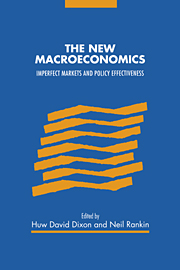Book contents
- Frontmatter
- Contents
- List of contributors
- Preface
- Acknowledgements
- Introduction
- Part I Overviews and perspectives
- Part II Goods market imperfections
- Part III Labour market imperfections
- 7 Demand uncertainty and unemployment in a monopoly union model
- 8 Efficiency wages as a persistence mechanism
- 9 Efficiency, enforceability and acyclical wages
- 10 Business fluctuations, worker moral hazard and optimal environmental policy
- Part IV Financial market imperfections
- Part V Nominal rigidities and bounded rationality
- Bibliography
- Index of authors
- Index of subjects
9 - Efficiency, enforceability and acyclical wages
Published online by Cambridge University Press: 13 October 2009
- Frontmatter
- Contents
- List of contributors
- Preface
- Acknowledgements
- Introduction
- Part I Overviews and perspectives
- Part II Goods market imperfections
- Part III Labour market imperfections
- 7 Demand uncertainty and unemployment in a monopoly union model
- 8 Efficiency wages as a persistence mechanism
- 9 Efficiency, enforceability and acyclical wages
- 10 Business fluctuations, worker moral hazard and optimal environmental policy
- Part IV Financial market imperfections
- Part V Nominal rigidities and bounded rationality
- Bibliography
- Index of authors
- Index of subjects
Summary
Introduction
One of the puzzles of modern macroeconomics is the apparent low volatility of the real wage over the business cycle. Employment tends to vary too much compared with the real wage, at least if the data are to fit standard macroeconomic models (see, for example, Blanchard and Fischer, 1989, for a quick empirical overview). The purpose of this chapter is to present a small model which can add to the understanding of why the real wage is so flat over the cycle.
We will study a simple example of a labour market where a firm employs a number of workers organized in a union. The union decides on the wage, the firm on the employment. The parties engage in a long-term relationship, and (as is well known) this gives them the opportunity to realize better outcomes than the one-shot non-cooperative equilibrium. The firm's revenue is subject to stochastic shocks: in some periods the (linear) demand curve is more favourable to the firm than in other periods. We focus on the efficient outcome sharing the surplus over the non-cooperative outcome equally. Here the wage is lower than in the non-cooperative outcome, and in return the firm employs more workers than it would like to do at this wage. When the parties' discount factor is sufficiently high, this outcome can be implemented in each period in a subgame perfect equilibrium of the infinitely repeated game.
- Type
- Chapter
- Information
- The New MacroeconomicsImperfect Markets and Policy Effectiveness, pp. 206 - 213Publisher: Cambridge University PressPrint publication year: 1995
- 1
- Cited by

